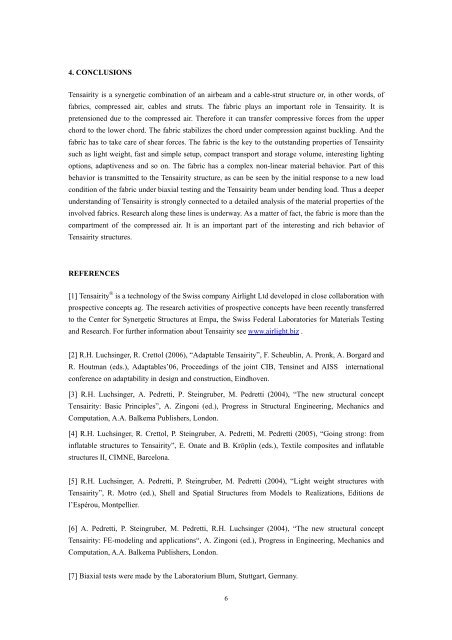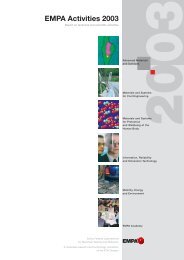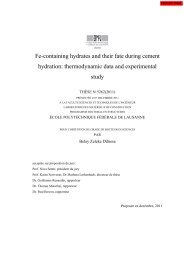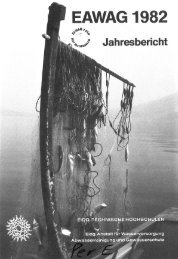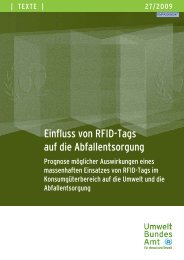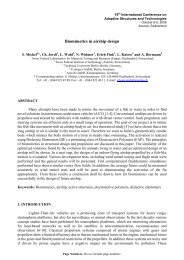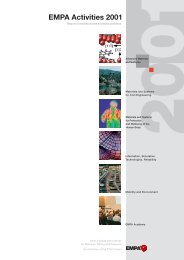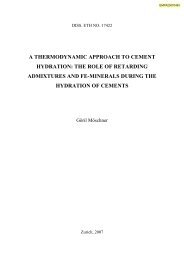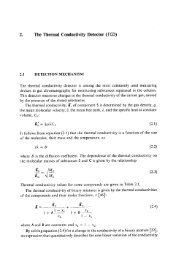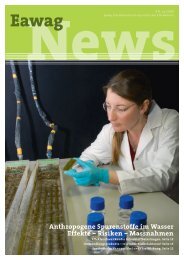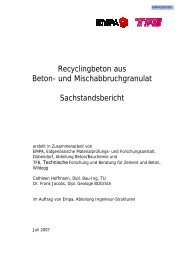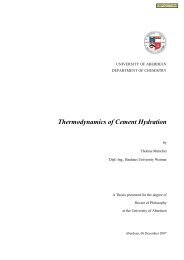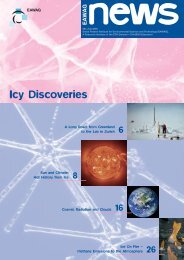THE ROLE OF FABRICS IN TENSAIRITY - Eawag-Empa Library
THE ROLE OF FABRICS IN TENSAIRITY - Eawag-Empa Library
THE ROLE OF FABRICS IN TENSAIRITY - Eawag-Empa Library
You also want an ePaper? Increase the reach of your titles
YUMPU automatically turns print PDFs into web optimized ePapers that Google loves.
4. CONCLUSIONS<br />
Tensairity is a synergetic combination of an airbeam and a cable-strut structure or, in other words, of<br />
fabrics, compressed air, cables and struts. The fabric plays an important role in Tensairity. It is<br />
pretensioned due to the compressed air. Therefore it can transfer compressive forces from the upper<br />
chord to the lower chord. The fabric stabilizes the chord under compression against buckling. And the<br />
fabric has to take care of shear forces. The fabric is the key to the outstanding properties of Tensairity<br />
such as light weight, fast and simple setup, compact transport and storage volume, interesting lighting<br />
options, adaptiveness and so on. The fabric has a complex non-linear material behavior. Part of this<br />
behavior is transmitted to the Tensairity structure, as can be seen by the initial response to a new load<br />
condition of the fabric under biaxial testing and the Tensairity beam under bending load. Thus a deeper<br />
understanding of Tensairity is strongly connected to a detailed analysis of the material properties of the<br />
involved fabrics. Research along these lines is underway. As a matter of fact, the fabric is more than the<br />
compartment of the compressed air. It is an important part of the interesting and rich behavior of<br />
Tensairity structures.<br />
REFERENCES<br />
[1] Tensairity ® is a technology of the Swiss company Airlight Ltd developed in close collaboration with<br />
prospective concepts ag. The research activities of prospective concepts have been recently transferred<br />
to the Center for Synergetic Structures at <strong>Empa</strong>, the Swiss Federal Laboratories for Materials Testing<br />
and Research. For further information about Tensairity see www.airlight.biz .<br />
[2] R.H. Luchsinger, R. Crettol (2006), “Adaptable Tensairity”, F. Scheublin, A. Pronk, A. Borgard and<br />
R. Houtman (eds.), Adaptables’06, Proceedings of the joint CIB, Tensinet and AISS international<br />
conference on adaptability in design and construction, Eindhoven.<br />
[3] R.H. Luchsinger, A. Pedretti, P. Steingruber, M. Pedretti (2004), “The new structural concept<br />
Tensairity: Basic Principles”, A. Zingoni (ed.), Progress in Structural Engineering, Mechanics and<br />
Computation, A.A. Balkema Publishers, London.<br />
[4] R.H. Luchsinger, R. Crettol, P. Steingruber, A. Pedretti, M. Pedretti (2005), “Going strong: from<br />
inflatable structures to Tensairity”, E. Onate and B. Kröplin (eds.), Textile composites and inflatable<br />
structures II, CIMNE, Barcelona.<br />
[5] R.H. Luchsinger, A. Pedretti, P. Steingruber, M. Pedretti (2004), “Light weight structures with<br />
Tensairity”, R. Motro (ed.), Shell and Spatial Structures from Models to Realizations, Editions de<br />
l’Espérou, Montpellier.<br />
[6] A. Pedretti, P. Steingruber, M. Pedretti, R.H. Luchsinger (2004), “The new structural concept<br />
Tensairity: FE-modeling and applications“, A. Zingoni (ed.), Progress in Engineering, Mechanics and<br />
Computation, A.A. Balkema Publishers, London.<br />
[7] Biaxial tests were made by the Laboratorium Blum, Stuttgart, Germany.<br />
6


